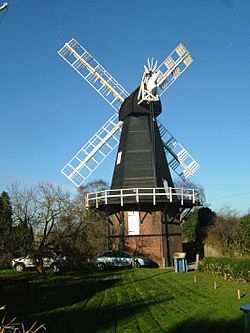Killick's Mill, Meopham facts for kids
Quick facts for kids Killick's Mill, Meopham |
|
|---|---|
 |
|
| Origin | |
| Grid reference | TQ 6394 6518 |
| Coordinates | 51°21′43″N 0°21′12.5″E / 51.36194°N 0.353472°E |
| Operator(s) | Kent County Council |
| Year built | 1801 |
| Information | |
| Purpose | Corn mill |
| Type | Smock mill |
| Storeys | Three-storey smock |
| Base storeys | Two-storey base |
| Smock sides | Six-sided |
| No. of sails | Four |
| Type of sails | Double Patent sails |
| Windshaft | Cast iron |
| Winding | Fantail |
| Fantail blades | Six blades |
| Auxiliary power | Oil engine |
| No. of pairs of millstones | Four pairs |
Killick's Mill is a special old smock mill located in Meopham, Kent, England. It was built in 1801 and has been carefully fixed up so people can still see it today. It's known as a Grade II* listed building, which means it's a very important historical site.
Contents
The Story of Killick's Mill
How the Mill Was Built
Killick's Mill was built in 1801 by three brothers from Strood named Killick. What makes this mill special is its shape. Most smock mills have eight sides, like an octagon. But Killick's Mill has only six sides, making it a unique hexagonal shape!
Who Ran the Mill?
The Killick family ran the mill for many years, until 1889. After that, the Norton family took over. The mill used wind power to grind corn until 1929. Later, it used an oil engine and then an electric motor to do the work, continuing until 1965.
Saving the Mill
In 1960, Kent County Council bought the mill to protect it. A company called E Hole and Sons, who were expert millwrights from Burgess Hill, restored the mill. This big repair job cost £4,375 at the time.
What Killick's Mill Looks Like Inside
Mill Structure and Sails
Killick's Mill is a three-storey smock mill. It sits on a two-storey brick base. There's a platform, called a stage, on the second floor. The mill has four large sails, known as double patent sails. These sails are about 27 feet (8.2 meters) long. They are attached to a strong cast-iron pole called a windshaft.
How the Mill Turns to Face the Wind
A special part called a fantail helps the mill turn to face the wind. This makes sure the sails always catch the most wind.
Inside the Mill's Machinery
Inside, there's a large wooden Brake Wheel that is about 6 feet 6 inches (2 meters) wide. Other important parts, like the Wallower and Great Spur Wheel, are made of cast iron.
Grinding the Corn
When the mill was first built, it had two pairs of millstones to grind corn. Over time, two more pairs were added, making a total of four. One of these extra pairs of stones came from another mill, Richardson's mill, in Boughton under Blean. An auxiliary oil engine, which was 15 horsepower (11 kW), also came from that mill. This engine helped power the stones. The stones grind the corn from the top, which is called "overdrift." At one point, the mill even made its own electricity to power lights inside!
Millers Who Worked at Killick's Mill
- James Killick (1801 - 1823)
- Sukey Killick (1823 - unknown)
- James Killick (1852 - 1889)
- Richard Killick (1882 - 1889)
- Thomas Killick (1882 - 1889)
- John Norton (1889 - unknown)
- William Norton (1889 - unknown)
- Leslie Norton (unknown)
- J & W Norton (1895 - 1950s)
- J & W Norton (Meopham) Ltd. (1950s - 1965)
Killick's Mill in Media
Killick's Mill was briefly shown in a TV show called The Prisoner. It appeared in an episode titled The Girl Who Was Death, which was filmed in 1967 and first shown in 1968.


